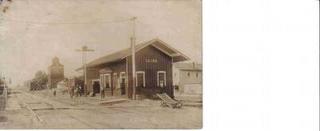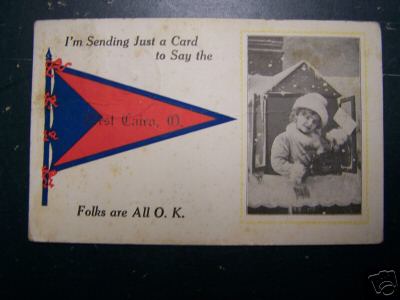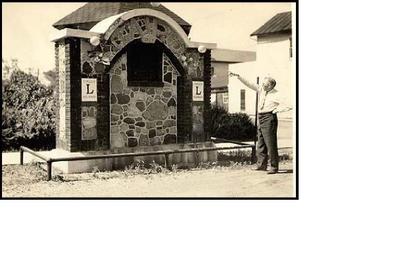
This is a postcard picture of the Baltimore & Ohio Railroad Depot in Tood's Town, Cairo, Ohio. This photo was taken before my time in Cairo and I can't really estimate the date of the photograph. Obviously it was before the street was paved. The street just to the north of the Depot is Main Street in Cairo and is a part of U.S. Route 30 which is the Lincoln Highway. It is my understanding that Route 30 was paved through Cairo in about 1937. The photograph could have been taken years before that.
Regardless of when the photo was taken, the Depot (and other buildings shown in the photograph) changed very little, if at all, between the time of the photo and my time in Cairo. The color of the Depot was changed from the photo. I remember it as being a beige color not the dark color shown in the photo.
The depot was located south of Main Street and west of the B&O right of way. In the background the taller dark building is the Cairo Elevator, which was a stock company when I was living in Cairo in the 1940s through the 1950s. The elevator is still there and still buys and sells grain and performs other services on behalf of the area farmers. I believe that it is owned by a farmer's cooperative that also owns the Columbus Grove Ohio elevator about 6 miles to the north.
At the end of the siding, there was a loading dock built from railroad ties for loading cattle onto train cars. I do not remember the dock being used while I was living in Cairo, but my mother told me that some of her relatives raised cattle and used the dock and the railroad to ship cattle to market.
The white building in the background to the immediate right of the depot was the home of the Independent Order of Odd Fellows lodge on the upper floor and and a burial vault factory on the lower floor. There Shelton Brenneman built burial vaults from concrete one at a time. Sheldy's shop was another place, where as boys, we visited almost every day.
The main elevator building shown in the photo had been expanded somewhat from the photograph at the time I was living in Cairo. Also, immediately behind the Elevator building, the Elevator had built a 150 foot tall concrete silo structure for drying and storing grain which was referred to as a "bean dryer". The bean dryer is by far the tallest structure in Cairo and is the landmark for locating Cairo for miles in the flat farmland surrounding Cairo.
From the early 1940s until about 1955, our family home was located just to the south of the Depot on the east (left) side of the railroad tracks. Our house is not visible in the photograph, but it is located about 20 feet to the east of the main line of the railroad.
The photograph appears to show a mail bag transfer structure on the east side of the tracks across from the Depot. When we lived on the railroad tracks, the mail bag transfer structure was located just to the south of our house in front of Marion "Corn" Rasors' house. The mail bag was held in position between upper and lower horizontally extending arms. The mail car was equipped with a hook that was extended and caught the center of the mail bag. The person extending the arm to catch the outgoing mail would also kick an incoming mail bag from the car almost simultaneously. In years of watching the transfer, I never saw an outgoing mail bag that was missed.
I spent part of almost everyday, sometimes a major part of the day, in the Depot watching the stationmaster, Vernon Sloan, play with the telegraph key and coordinate the small flow of freight and passengers in and out of Tood's Town. The telegraph was almost always clicking away transmitting messages about railroad traffic in Morse code. In my recollection, the messages were virtually never for the Cairo stationmaster. Most of the messages involved events in Lima, Leipsic, or Toledo.
Most of the railroad activity in Cairo was to pick up mail and box cars of grain that had been stored in the Elevator and sold to a grain dealer, Anderson's, on the Maumee River in Toledo. Anderson's are still there on the North bank of the Maumee River at Interstate 75 in Toledo. At that time, Anderson's was a relatively small family business. Today, judging from the size of the Toledo location, Anderson's appears to be a huge, international business.
In the mid to late 1950s, the American Agricultural Chemical Company ("Agrico") built and operated a large agricultural chemical plant (fertilizer) one mile north of Cairo on Route 65. This plant provided employment for several local residents. Given the weight of the fertilizer bags and the oppressive fertilizer dust, the work was brutal. I worked for a month or so at the Agrico plant stacking 50 pound bags of fertilizer.
Like me, most people worked at Agrico for only a short period of time because the work was so physical and filthy. The fertilizer dust was everywhere and could not have been beneficial for the lungs. Dust masks were required but only partially effective. In addition, the plant manufactured sulphuric acid for use in the fertilizer. The vapors of sulphuric acid were very caustic and permeated everywhere throughout the plant and well beyond.
In the summer of 1957, I worked at the Agrico plant building a railroad spur from the B&O railroad which bordered the plant on the east. The spur we built was only about a half mile long, but involved tremendous physical effort. Moving sections of rail and railroad ties, placing the ties and laying the rails using spikes and hammers put me in the best physical condition of my life. In the first days of building the spur, I would go to work at 7:00 a.m., work until 6:00 p.m. and go home and go to bed in my clothes and sleep until it was time to go back to work the next day. I thought I was in good condition when I started, but it took more than one week to get into the physical condition required to do a full day's work without reaching the point of exhaustion.
In an earlier blog, I told part of the story of Paul Cahill. Paul spent the last 2 or 3 years of his life setting on the step of the doorway to the Depot that is nearest the photographer. During that period, Paul seldom spoke, he just set in the doorway with his cane between his legs and stared. Stared at nothing in Tood's Town but stared at things he had experienced during his service in the islands of the South Pacific and especially in Bataan.
The north end of the Depot was the passenger area. Not many passengers used the railroad for transportation in the 1940s and even less in the 1950s, but the passenger area was well maintained. I estimated that the passenger area was about 20' x 20'. It was nicely paneled in a dark wood and included a low wooden bench along almost the entire periphery of the north, west and south walls. The floor of the passenger area was also wood. The floors of station master and freight areas were wooden planks. There was a cast iron wood stove in the south central part of the passenger area.
The south end of the Depot was for freight and housed tools used by the section crew. The section foreman was Lester "Peanut" Wood and his crew included Felix Thomas and Tiny Martz. They were responsible for maintaining the ties and tracks for several miles north and south of Tood's Town. They traveled to and from their work sites on a small motorized "hand car". The hand car was kept in a small yellow building across the tracks from and just south of the Elevator on the east side of the tracks. The "handcar" had steel wheels that matched the width of the track and a small gasoline engine that propelled the car at about 10 miles per hour. One of the things I remember about the handcar was a small wooden barrel (about 2 gallons) that hung from the back of the car and was the day's water supply for the section crew.
The stationmaster was located in the center portion of the Depot which can be identified in the photograph by the bay window which allowed the stationmaster to observe the tracks both north and south.
The Depot and the hand car shed no longer exist. I don't know when it was removed.
As a matter of interest and for reference, Tood's mother's house, with whom Tood lived was located on the east side of the tracks and just north of Main Street. The camera taking the photograph of the depot was apparently located near the Southwest corner of Tood's property when the photograph was taken.
Until later.
Dillard Farnsworth



